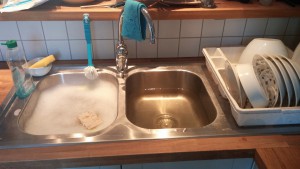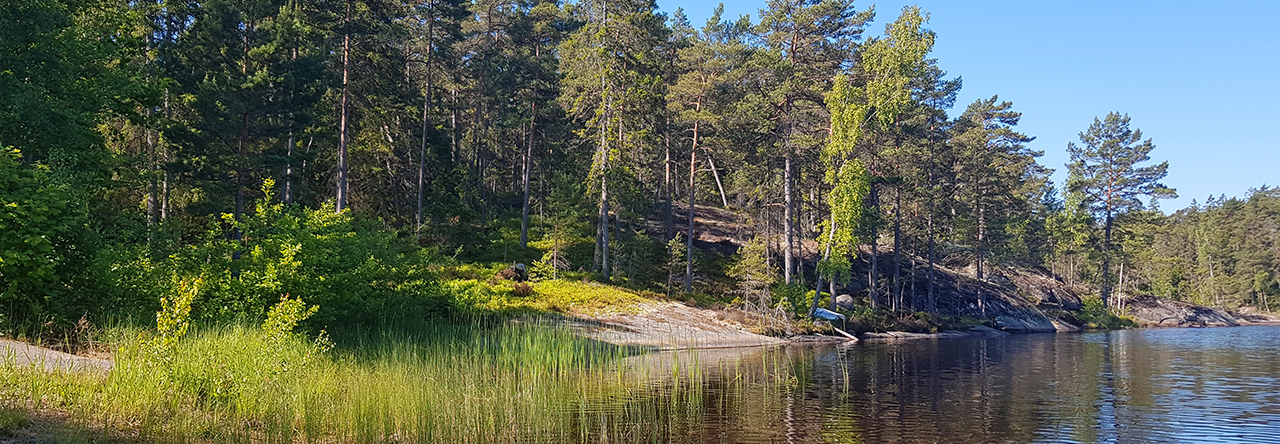My family — my husband, my son and myself — have been spending our summers at our little piece of property out in the Swedish archipelago since our son was almost 2 years old. The boy is now almost 25 so I’ll let you do the math on how long we’ve been going out there.
The property had been in my husband’s family since his parents bought the land in the mid 50’s. By the time we starting going out there, the larger of the two buildings (hand built by my husband’s father) had become a 25 square meter run-down, moldy cabin. While it had electricity, it had no running water. In fact there was no running water anywhere on the property, except when it rained and then the area that we would refer to as the lawn became a small lake that slowly trickled downstream through the grass. The only toilet facilities we had was the outhouse, a short walk down the hill from our cabin.
We spent the first 8 summers out there fixing up the small 2-room building: new roof, new paneling on the outside with a new coat of paint, a “kitchen” makeover with new windows, wood paneling on the ceiling, new floor tiles, paint and wallpaper. We kept the kitchen cabinets from the 1970’s and the tiny 2-burner electric stove (just gave them a very through scrubbing). We got our drinking water out of the 20-liter plastic jugs we filled from the hand pump a 5-minute drive down the road. Water to wash dishes and ourselves was delivered through a thick black hose run from the nearby lake to a tiny hot water heater hung up on the outside of the cabin. We never did manage to get rid of the moldy-house smell though.
We also never got around to fixing up the cabin’s “big” room; partially because we couldn’t agree on what to do with it and mainly because after 8 years of tiny-cabin life, we bought a larger, new pre-fab house. The factory-painted pre-fab was delivered on a big truck with 2 carpenters to put it together and 2 days later we had what looked like a complete new house. Lying on the ground next to it were all the building materials needed to complete the inside of the house. Because we considered ourselves “handy” we decided that we would finish the inside of the house all on our own. Every summer of the next 7 years we spent working on the Big House. We put up gutters and drainpipes. We spent a summer just on the floors; putting in all the insulation and the floorboards. Another summer we did the same for the ceilings. Another year a carpenter friend spent a weekend putting up all the inner walls and we spent the rest of the summer with insulation and screwing up plasterboard. My husband spent weeks standing on a ladder, holding a nail gun, putting up the wood paneled ceiling. Finally in the middle of the vaulted living room ceiling, he decided he had had enough!
The following summer, we called in a crew of Polish carpenters who spent 5 or 6 weeks of plastering, wallpapering, painting, window framing, laminate flooring installation and kitchen building. By the end of that summer the house was ready to live in. So in 2009, we spent our first summer in the Big House.
During all the years we spent working on the new house, we continued to live in our tiny 2-room shack: brushing our teeth at night, standing outside while holding a plastic cup as we looked up at the night sky; washing dishes outside on the bench attached to the back wall of the cabin, hoping the rain would hold off until we got them all done; hoping we didn’t have to poop at night because who wants to have to walk down to the outhouse in the middle of the night, though in July it never really got dark so that was sort of OK.
Even after we started to spend our summers living in the new big house, we still had no indoor water even though we had dug a well a few years earlier. The “bathroom” was used as a glorified tool shed and the sinks in the new kitchen couldn’t hold water. Life in the countryside had become more comfortable but we still continued to wash dishes on a wooden bench behind the new house, took showers only when the weather was warm and sunny, brushed our teeth out on the deck as we looked at the stars, and traipsed down to use our outhouse carrying flashlights when necessary.
But then last summer my husband decided it was time to become civilized. He bought a Cinderella incinerating toilet. He hired a carpenter to build us a real bathroom with tiled walls and floor, a real shower, a sink and vanity and a mirrored wall cabinet. And a plumber to connect our well and water pump to the inside of our house.
 This weekend was the second weekend I have spent here in our new civilized country house. It is early April and still cold outside. And rainy. And mostly grey and dreary. But inside its warm and cozy. I washed the dinner dishes without having to drag them outside first. I haven’t gone down to the outhouse once — its probably all full of spiderwebs by now, left over from the winter, but I haven’t had the need to check. And while I haven’t tried out the shower yet, I know that I can use it without having to check the weather report first.
This weekend was the second weekend I have spent here in our new civilized country house. It is early April and still cold outside. And rainy. And mostly grey and dreary. But inside its warm and cozy. I washed the dinner dishes without having to drag them outside first. I haven’t gone down to the outhouse once — its probably all full of spiderwebs by now, left over from the winter, but I haven’t had the need to check. And while I haven’t tried out the shower yet, I know that I can use it without having to check the weather report first.
But with all this new unaccustomed civilization at my fingertips, I find that I am missing something. I find myself missing that close proximity with all the vagaries of nature: feeling the rain come down as I finish washing the last dish; the chilly air on my face as I make my way down to the outhouse; the cold wet decking under my bare feet as I go out to brush my teeth. Yes, civilization has its advantages, but at the same time it also tends to disconnect us from the natural world around us. And this former New York City girl is forced to admit that she misses that connection — even after all those years of complaining about it. The cold and the rain and the damp isn’t all that bad; as long as you can come into the warmth of civilization afterwards.
This story was first published April 10, 2016 on Medium.com

Leave a Reply